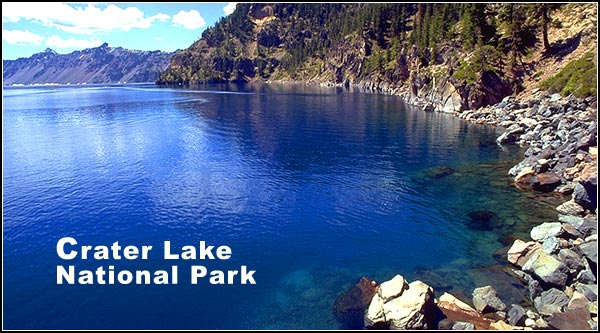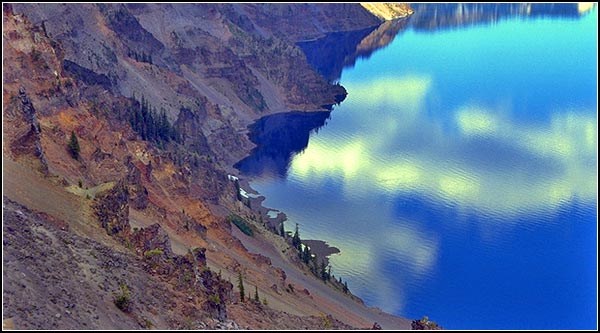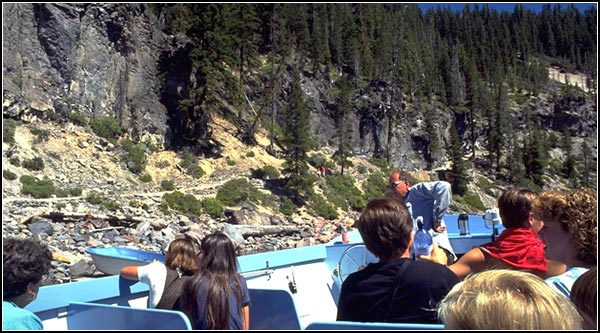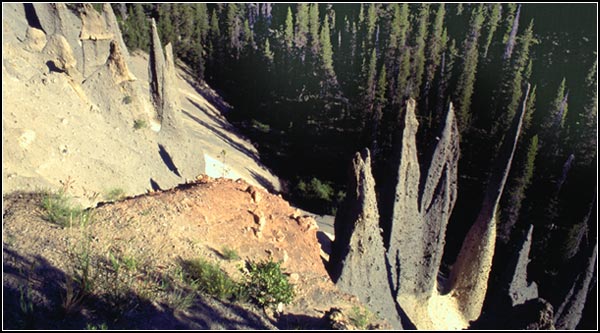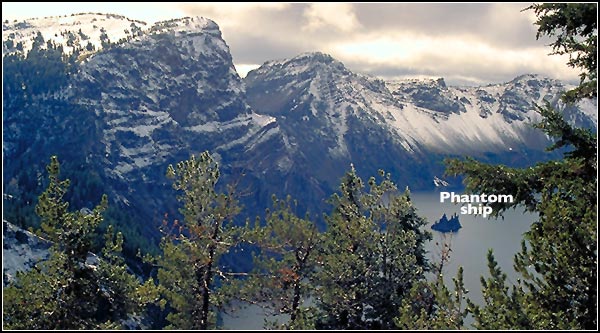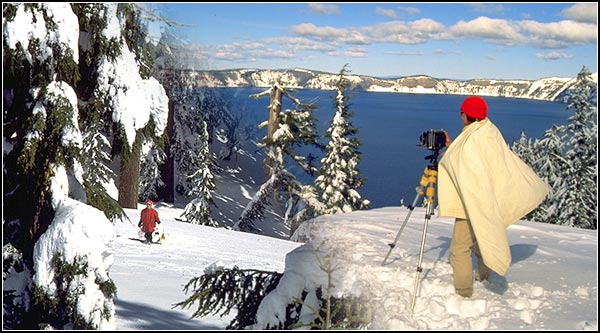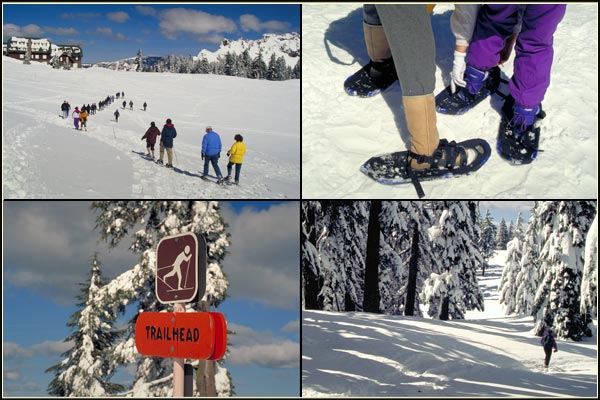A deep blue that will take your breath away
Crater Lake is 1,943 feet at it’s deepest point,the seventh deepest
lake in the world and the deepest in the United States. Lake levels
fluctuate slightly from year to year. Winter snows supply the lake
with water. Crater Lake, 42.95°N 122.10°W, is a 45 minute drive from
Harriman Springs Resort & Marina, a trip to a spectacular world unlike
any other. It is no wonder that Crater Lake is a National Park.
400,000 years in the making and boom!
Crater Lake lies inside a caldera, or volcanic basin, created when
12,000 foot high Mount Mazama collapsed 7,700 years ago following a
large eruption. The lake averages more than five miles in diameter,
and is surrounded by steep walls that rise up to 2,300 feet above its
surface. Wizard Island rises 764 feet above the lake surface. Mt. Scott,
at 8,929 feet, is the park’s highest point.
More than a special place it is a special spirit
Upwards of 500,000 people visit Crater Lake. The park is open year
round with July and August being the busiest months. Lake temperature
varies between 32 and 66 degrees at the surface. More than 260 feet
below the surface, the water remains a constant 39 degrees year-round.
Seeing a wind-blown sky within the water
On June 25, 1997 scientists recorded a record clarity reading of 142 feet
– 43.3 meters. Crater Lake is one of the clearest lakes in the world.
It usually has clarity readings of 80 to 115 feet.
Seeing the lake by tour boat is beyond an E-class ticket
Crater lake is an unique ecosystem. Scientists have identified 157 species
of phytoplankton and 12 species of zooplankton in the lake. Large colonies
of moss circle the lake at depths of up to 400 feet. At the bottom of the
lake, communities of bacteria gather around at least two areas of hydrothermal
activity. Rainbow trout and kokanee salmon thrive in the lake, the result
of stocking between 1888 and 1942. A 6.5 pound, 26 inch long rainbow trout
has been documented. Fishing is allowed at Cleetwood Cove and
on Wizard Island. No fishing license is required.
Geology, natural and cultural history come alive
Imagine spending a couple of hours circumnavigating a volcano from
inside on a deep lake. To board the tour boats in Cleetwood Cove one must
descend a 1.1 mile trail which drops 700 feet from road to water level.
This is an experience in and of itself. Three are other tours that allows
people to spend as much as six hours on Wizard Island. One is far far
way from the modern world. The price of admission is well worth it.
On the road up to the lake’s rim
There are 700 plant, 52 mammal, 8 amphibian, 4 reptile, 5 fish, and 151
bird species in Crater Lake National Park. The park is much more than
the legendary lake itself. There are canyons and creeks cutting down the
slopes. Here, two observers look up a canyon at fumeroles.
Away from away are the Pinnacles.
Off of Rim Drive one can take Pinnacles Road which leads to Pinnacles
Valley and Pinnacles overlook. When Mt. Mazama literally blew its top
off 200 to 300 foot deposits of gas-charged hot ash and pumice surrounded
the volcano. Hot gas escaped through fumaroles formed by the hot gas bonding
ash and pumice into channels. The tall pinnacles are the result of eroding
loose ash and pumice leaving the cemented material.
Recognized as a national, and international, treasure
Phantom and Wizard are the two islands in the lake. The park comprises
183,224 acres, 90% is managed as wilderness area. Crater Lake was
established as the seventh national park on May 22, 1902. This photo
was taken on the year’s last day rim drive was open to the public.
That night a snow storm made the drive impassable. It might not be
reopened until June depending on that year’s conditions.
Few places in the northwest received more snow than Crater Lake
Winter brings some of the heaviest snowfall in the country, averaging 533
inches per year. Although park facilities mostly close for the season, the
park’s south entrance is kept open for visitors. Snow can still be on the
ground in early summer.
A sunny winter day is a snowy wonderland to enjoy.
The air is crisp. The silence echoes off the caldera walls. A photograph
frames an image that will not rival the experience of being there. A person
takes off alone into the forest. times like this one cannot truly be alone
because they are with Crater Lake.
Moving around in the winter is an aerobic and aromatic experience
Cross-country skiing and snowshoe hikes make Crater Lake a winter wonderland.
Crater Lake has 90 miles of maintained trails and 74 miles of paved road, including the
33 mile rim drive that circles the lake. What opportunities for winter explorations.
It is a pleasure for one to say they visited Crater Lake
The bottom of Crater Lake is close to the elevation of these fences and barns.
This photo is taken from a road that takes one to Kimball Park another
majestic destination. Here, springs coming out the cliffs feed the Wood River
at the feet of Mt. Mazama, home of Crater Lake National Park.
Join Bob Ganey American Tourist at Crater lake
On the Way to Crater Lake from Harriman Springs
Like No Place Else On Earth
The following is from the Crater Lake National Park’s home page –
“Crater Lake has inspired people for thousands of years. No place
else on earth combines a deep, pure lake, so blue in color; sheer surrounding
cliffs, almost two thousand feet high; two picturesque islands; and a violent
volcanic past. It is a place of immeasurable beauty, and an outstanding outdoor
laboratory and classroom.” The map is courtesy of the U.S.G.S. For more information visit Crater Lake National Park
©2013 Anders Tomlinson and Robert Ganey, all rights reserved.

